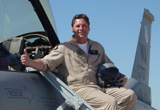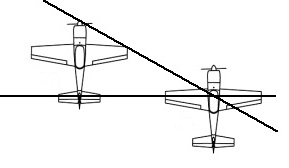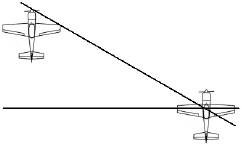TOPIC: BASIC GUIDELINES FOR FORMATION FLYING
 GUEST APS WRITER: Norman Rennspies
GUEST APS WRITER: Norman Rennspies
APS UPRT Instructor
Former USAF F-16 Instructor Pilot – 20 Years
Combat Vet – Desert Storm
Graduate USAF Fighter Weapons Instructor School
Formation flying is fun and inherently dangerous when you are flying with another aircraft only a few feet apart. For those with the proper training and discipline, flying a formation “mission” can be an efficient way to get two or more aircraft to their destination. There are certainly many other reasons to fly formation. To minimize the danger, we must exercise discipline and follow the chain of command within the formation and, in the case of a two-ship (element) formation, the lead and wingman have distinct roles and responsibilities to ensure the safety and success of the flight.
The scope of this article will be limited to some basic ground rules for “element” 2-ship formation operations.
Formation discipline is essential for the safety and control of all formation flights. The integrity of a formation can only be maintained when the leader has complete knowledge and control of the actions of each flight member. The flight leader must brief the formations to be flown and formation responsibilities. The wingman will maintain assigned formation position until a change is approved by the flight lead.
The flight lead is “in command” both on the ground and in the air. He has the general responsibility for planning and organizing the mission, leading the flight, delegating tasks within the flight to ensure the mission is safely accomplished. The flight lead must know the capability and limitations of the wingman. On the ground the flight lead will plan, brief and debrief the mission. He may delegate tasks within the flight. Once airborne, he has the final responsibility for navigating, communicating, formation airmanship and leading the flight successfully through the mission.
The wingmen also have critical responsibilities. On the ground they help the leader plan and organize the mission. Once airborne, they fly and maintain the assigned formation position, maintain sight of lead at all times, are responsible for safe separation from the lead aircraft at all times, have visual clearing responsibilities, and may perform back-up navigation tasks. It is essential that the wingmen understand their briefed responsibilities and execute their contract with discipline.
Discipline is the most important quality a pilot can posses and leads to success in the aerial environment. Discipline is executing self-control, maturity, and judgment in this high stress, emotionally charged, fun environment. Teamwork is the foundation of the flying element. If all flight members know and perform their respective duties with discipline, they work together as an effective team.
Discipline within a formation starts with communications, whether by radio or visual signals. If communicating by radio, it is important to have a discrete frequency. If this is not possible, then visual signals should be used to prevent using the ATC frequency. All communications must be clearly understood by every flight member. Radio discipline requires not only clarity and brevity in the message itself, but limiting unnecessary transmissions as well. Just as if you were speaking to a controlling agency, the first part of the radio transmission should always be the “call sign”. This alerts the listener that a message is coming (attention step) and to specify to whom it is directed (i.e. “Combat 2 say fuel”). For acknowledgement immediately following a radio call from lead, flight number with the appropriate response should be used (i.e. “2 has 18”). For all initiated calls or a response that is delayed, full call signs should be used (i.e. “Combat 2, has 18”). Briefed brevity words enhance situational awareness between and within flights; improper use of those brevity words (poor discipline) will quickly degrade situation awareness, which could lead invariably to disastrous results. Limit radio use within the flight to essential calls only (i.e. Combat 1, descend, traffic left 11, level, 2000 feet.”) Only standard visual signals should be used unless the flight leader specifically briefs non-standard signals.
The flight leader will initiate ops checks. This is the time to confirm proper fuel state, fuel transfer, engine operation, and operation of life support equipment (if required). It is each pilot’s responsibility to continually check these items without prompting by the flight leader. Even as a wingman you are still the Pilot in Command of your aircraft.
In-flight lead changes require an unmistakable transfer of responsibilities from one flight member to another. Lead changes can be initiated and acknowledged with either a radio call or visual signal. Visual contact with the new lead is required prior to initiating a lead change. The flight member assuming lead should be no further aft than the normal route/fingertip position prior to initiating or acknowledging the lead change. The lead change is effective upon acknowledgment. All flight members must continue to ensure aircraft separation as positions are changed. The new leader will continue to monitor the new wingman’s position until the leader is established in front with the wingman looking at the lead.
As a flight lead you must be considerate of your wingman. Fly smoothly and predictable. Monitor the wingman’s position while knowing your energy state (altitude and airspeed) and those of all aircraft in the flight as you are maneuvering. You do not want to over “G”; neither do you want to stall any of your flight members when you are maneuvering.
Before you can master formation flying as a wingman you must know what position you are supposed to be in. Formation references depend on the type of aircraft you are flying and what position you are flying. You most likely will have a wing-line reference and a longitudinal reference. Along with these references you will need to maintain wingtip/nose-tail separation. Some basic formations are; close (see Fig. 1) normally 3 to 10 feet of lateral separation, Route (See Fig. 2) – greater then 10 ft to 3 wingspans separation, close trail –below lead’s prop/jet wash and directly behind the leader with nose/tail separation. Regardless of which formation position you are in you must always continue to scan all references. Keep checking your wing-line and longitudinal references to ensure safe separation. In close formation these references should intersect right through the base of you neck in all attitudes and throughout all maneuvers.


When directed to do so, it is the duty of the wingman to leave the formation:
- When you lose sight of the leader’s aircraft
- When you are unable to join or to stay in formation without crossing over, under, or in front of Lead’s aircraft.
- At any other time you feel that your presence in the formation constitutes a hazard.
When you leave the formation, clear yourself in the direction of your turn and notify the leader. If you have lost sight of the lead, turn away from his last know position. Once you reacquire the flight lead, you must request permission to rejoin the formation (i.e. “Combat 1, 2 is visual, request rejoin”). Rejoin only when directed to do so by the flight lead (i.e. “Combat 2, cleared route right side”).
Formation flying is fun. It is also a very “Hands-on” skill that requires substantial flight time to master both as lead and as a wingman. Once you understand the “what” and “why” then you can be taught the “how” by doing. Eventually the skill becomes second nature and as a wingman it’s more about staying ahead of the lead aircraft and continually striving for the ideal position by corrective control pressures and throttle movement. Come on out and see us again. We can and will be more than happy to help in your quest to tame the dangers and master the joys of Formation Flying.
References used:
1. APS ACM Booklet, Introductory Tactical Reference Guide Version 3- Revision 2
2. Multi-command Handbook 11-F16, Volume 5 10 May1996
So what is your best defense in aircraft unusual attitude or upset conditions?
What is your best defense in aircraft unusual attitude or upset conditions?
- First, attempt to avoid conditions that can induce unusual attitudes in the first place! Steer clear of thunderstorms and wake turbulence! Avoid IMC or flight into low visibility conditions if not properly certificated and trained. Avoid distractions.
- Second, get the proper training. According to an article in AW&ST (May 8, 1995 issue): “Training should include flights in aerobatic aircraft to practice recovery techniques because no simulator can model the disorientation of actually being upside down… recurrent training every two years, with time in an actual aircraft, would be a good start.” Regardless of the aircraft that you fly, proper training will enable you to learn to react decisively in a high-pressure environment, and to learn proper recovery techniques to avoid a “panic” response that could worsen the situation.
- Contact a APS – Emergency Maneuver Training representative. Certainly, we would like to take this opportunity to recommend our program at APS which offers three course layouts to choose from. Please give us a call a 1-866-FLY-HARD and ask to speak with a flight training specialist or submit the online form below.
Get this training somewhere. The life you save may be more than just your own.




Comments: